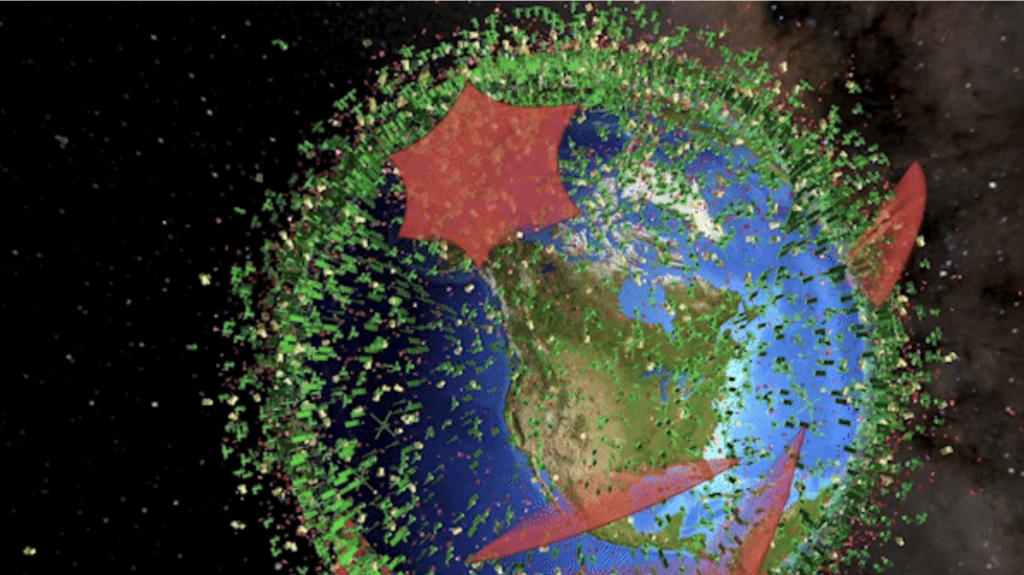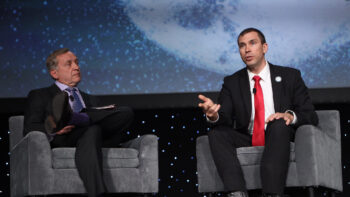
A new LeoLabs’ software tool allows insurers to visualize collision risks to client satellites. (LeoLabs)
AMOS 2022 — A new LeoLabs space monitoring tool will allow insurance companies to more accurately assess risks that spacecraft will smash into each other or dangerous space debris while transiting the ever-more crowded low Earth orbit (LEO) environment.
The tool, according to insurance experts, could potentially incentivize more firms to provide coverage for on-orbit activities, and in turn help operators by providing a modicum of financial security and encouraging investors.
LeoLabs has released what the company calls a “beta version” of the software analysis and visualization tool, utilizing the company’s vast space surveillance database. LeoLabs will begin selling the tool on the market in 2023, Darren McKnight, who developed it for the firm, told Breaking Defense Monday on the margins of the Advanced Maui Optical and Space Surveillance Technologies (AMOS) Conference in Hawaii.
The company owns a globe-spanning network of ground-based radars to detect and track space objects in LEO, and earlier this month received a first-of-a-kind contract from the Commerce Department. Under that agreement, LeoLabs will provide data for Commerce’s future space situational awareness service that will take over from the Defense Department the mission of helping civil, commercial and non-US operators keep their satellites safe.
The firm’s website explains that the software tool allows users to determine collision risks for single or multiple satellites; calculate risk probabilities; predict future collision risks; visualize the LEO environment and the whereabouts of space objects (with tracking updated every two weeks, according to McKnight); and run “forensic analyses” in the wake of a collision. Thus, the tool could also be useful not just for insurers, but also for investors and government agencies (such as DoD) planning where in orbit to put new satellites.
McKnight said he worked directly with insurance firm Axa XL, a US subsidiary of French insurance giant Axa S.A., in order to ensure that the software is easy to use, while still providing all the necessary data for brokers to tailor risk assessments for their clients.
“We worked with LeoLabs to design and implement the collision hazard tool — it’s quite exquisite,” Chris Kunstadter, Axa Xl global head of space, confirmed in an email. “We will certainly use it in our underwriting analysis.”
In a presentation to the National Space Council on Sept. 9, Kunstadter explained the role of insurance in the global space economy, and its potential to also incentive operators to take space safety seriously.
“Space is a fundamental part of the global economy and space insurance for launching and in-orbit operations is a critical enabler of innovation and investment. We provide the financial certainty that allows companies to develop novel technologies and applications and encourages investors, including the US government, to support these activities,” he said then.
“In my work, I partner with satellite and launch operators and manufacturers, government agencies and many others to promote safety and incentivize responsible space activity. We actively support companies developing innovative solutions for space traffic management, such as miniature beacons and ground-based radars for tracking objects and small, low-power propulsion for collision avoidance and post mission disposal,” he added.
Denis Bensousan, head of space at London-based insurance firm Beazley, said that while he could not directly comment on the tool, its creation is a boon for future space safety.
“It’s a new and encouraging step in the right direction in terms of space domain awareness and a welcome collaboration within the industry that should allow a better assessment of the LEO environment and its risks to the extent that the information is reliable, timely, up to date and operational,” he told Breaking Defense in an email.
That said, Bensousan noted that it might not have a big impact on the price of in-space insurance, since “the risk of in-orbit collision while material and increasing is only a minor contributing factor to satellite failure, mission disruption or degraded performance” — with the most likely cause being “technical anomalies.”
Another issue is the potential for vendor lock, and reliance on a single type of sensor to source space monitoring data (i.e. radar), he said. “More comprehensive services may be more adapted to need/demand.”
Nonetheless, Bensousan praised the initiative as a way to spotlight the need for better on-orbit risk analysis.
“It can help raise further awareness/interest into this subject and spur further needed developments and industry cooperation in respect of orbital traffic management and analytics,” he said.
McKnight said the insurance tool as just one of a suite of software-based analytical capabilities that LeoLabs intends to offer as part of its “lifecycle space safety” business.
“We look at design, we look at manufacture, we look at trade offs for spacecraft [development], we look at investment, we look at insurance, we look at collision avoidance, but then we also look at regulatory issues,” he said, noting the firm’s work to help the New Zealand Space Agency assess risks when it is licensing its satellite operators.
“We give the ‘full monty’ collision avoidance services,” he said.






















